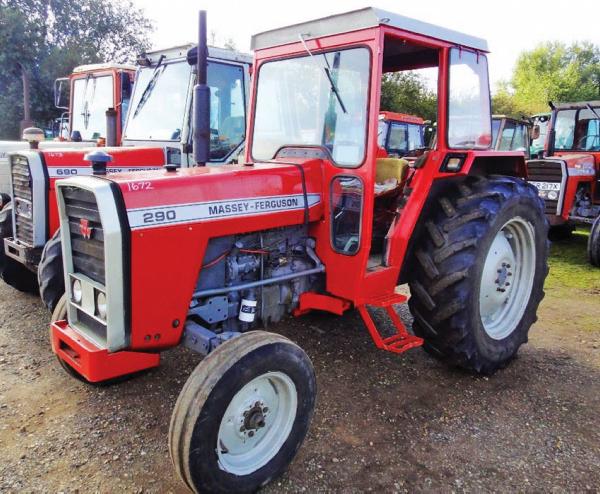
LOYALTY CODE:
The paper code cannot be redeemed when browsing in private/incognito mode. Please go to a normal browser window and enter the code there

LOYALTY CODE:
The paper code cannot be redeemed when browsing in private/incognito mode. Please go to a normal browser window and enter the code there
This content is copyright protected!
However, if you would like to share the information in this article, you may use the headline, summary and link below:
Title: MF 200 series followed a turbulent decade
Following the launch of the Massey Ferguson ‘500 Series’ tractors in 1975, the ‘200 Series’ models were introduced in 1979. Robert Kierans reports
https://www.farmersjournal.ie/mf-200-series-followed-a-turbulent-decade-151684

ENTER YOUR LOYALTY CODE:
The reader loyalty code gives you full access to the site from when you enter it until the following Wednesday at 9pm. Find your unique code on the back page of Irish Country Living every week.

CODE ACCEPTED

You have full access to farmersjournal.ie on this browser until 9pm next Wednesday. Thank you for buying the paper and using the code.

CODE NOT VALID
Please try again or contact us.
For assistance, call 01 4199525
or email subs@farmersjournal.ie
Sign in

Incorrect details
Please try again or reset password
If would like to speak to a member of
our team, please call us on 01-4199525
Reset
password
Please enter your email address and we
will send you a link to reset your password

If would like to speak to a member of
our team, please call us on 01-4199525
Link sent to
your email
address
![]()
We have sent an email to your address.
Please click on the link in this email to reset
your password. If you can't find it in your inbox,
please check your spam folder. If you can't
find the email, please call us on 01-4199525.
![]()
Email address
not recognised
There is no subscription associated with this email
address. To read our subscriber-only content.
please subscribe or use the reader loyalty code.
If would like to speak to a member of
our team, please call us on 01-4199525
 This is a subscriber-only article
This is a subscriber-only article
Update Success !

The 1970s was a turbulent decade for Massey Ferguson, with employee strikes and high inflation and interest rates dominating the economic landscape.
The 1980s also brought great challenges as demand for agricultural tractors and machinery declined. Nevertheless, Massey Ferguson maintained its strong position in sales charts both in Britain and abroad.
The new ‘200 Series’ range consisted of the 230, 240, 250, 265, 275 and 290 models. The tractors were powered by three and four-cylinder Perkins diesel engines, and the flagship of the range, the Massey Ferguson 290, had a power output of 77hp.
The ‘200 Series’ tractors were similar in appearance to the ‘500 Series’ models, with modern straight-line styling and a rectangular removable front grille, behind which each tractor’s battery and windscreen washer bottle could be found.
The tractors were designed to be easily serviced, and access to components, such as the fuel and oil filters, was excellent.
Unlike the ‘500 Series’ range, the ‘200 Series’ models were not fitted with fully integrated ‘supercabs,’ but cabs made by manufacturers such as GKN Sankey, Cabcraft and Lambourne, of which the GKN offering was the most popular with its forward hinged detachable doors.
The largest tractors of the range were fitted with a split-torque clutch, replacing the dual clutch arrangement of their predecessors.
Whereas dual clutch assemblies had two clutch plates, one for transmitting drive to the gearbox, the other to the pto, the split-torque unit featured a single clutch plate. This transmitted power to the transmission while drive to the pto was continuous via a splined shaft, which could be engaged when required. A two-speed pto offering a choice of either 540rpm or 1,000rpm was optional on the ‘200 Series’ models.
The tractors were also fitted with a choice of gearboxes, ranging from an entry-level non-synchromesh transmission providing eight forward and two reverse speeds to a 12-speed synchromesh unit. Massey Ferguson’s clutch-less 12-speed ‘Multi-Power’ gearbox was also available.
The flagship four-wheel drive Massey Ferguson 290 had 11.2/10-28” front and 13.6/12-28” rear wheels as standard, while the two-wheel drive variant came with 7.50 X 16” front wheels. Larger tyres were optional on the model.
The tractor was also fitted with disc brakes, category two rear linkage, two spool valves and draft and position control.
The ‘200 Series’ tractors proved to be a popular choice among the farming community of the era due to their reliability and simplicity. They were one of the last tractor ranges launched before electronics began to play a major role in tractor design.
The ‘200 Series’ range was superseded by the ‘300 Series’ line-up in 1986, and to this day many examples can be found hard at work on farms around the world.
*robertkierans@hotmail.com
SHARING OPTIONS: